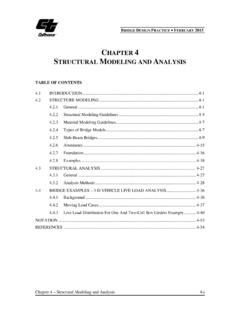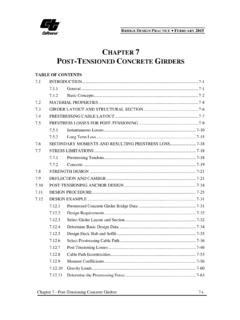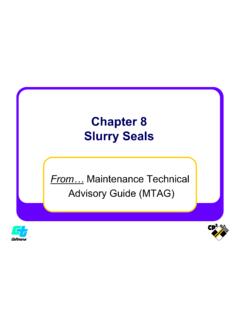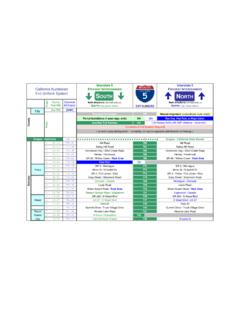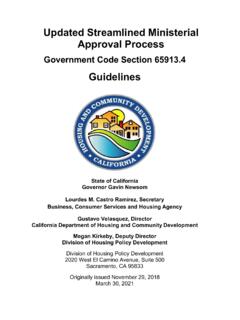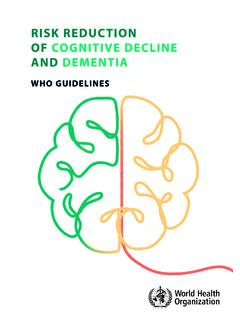Transcription of Vehicle Miles TraveledFocused Transportation Impact Study ...
1 Vehicle Miles Traveled-Focused Transportation Impact Study Guide May 20, 2020 V MT-Focused TISG Page 2 TABLE OF CONTENTS Use of this Guidance ..3 1. Introduction ..4 Change s to C EQA ..4 Caltrans Updates Its Review of Land Use Decisions and 2. Reducing Greenhouse Gas Emissions and Vehicle Miles Traveled ..7 3. Caltrans Review of Local Development Projects ..8 V MT Analysis is Caltrans Focus ..8 VMT Calculation ..9 4. Projects Presumed to Have a Less than Significant Transportation Impact .. 10 Caltrans Review of Projects Presumed to Have A Less Than Significant Impact .. 11 5. Projects Without Presumption of Less Than Significant 13 Caltrans Review of Projects Without Presumption of Less Than Significant Impact .
2 13 6. Rural Areas Outside of Metropolitan Planning Organizations (MPOs) .. 15 7. Mitigating Transportation Impacts .. 16 8. Appendix .. 19 V MT-Focused TISG Page 3 U s e of this Guidance The Transportation Impact Study Guide (TISG) was prepared by the State of California, Department of Transportation (Caltrans) to provide guidance to Caltrans Districts, lead agencies, tribal governments, developers and consultants regarding Caltrans review of a land use project or plan s Transportation analysis using a Vehicle Miles traveled (V MT) metric. This guidance is not binding on public agencies and it is intended to be a reference and informational document. The guidance may be updated based upon need, or in response to updates of the Governor s Office of Planning and Research s Technical Advisory on Evaluating Transportation Impacts in CEQA.
3 The TISG replaces the Guide for the Preparation of Traffic Impact Studies ( Cal trans, 2002) and is for use with local land use projects, not for Transportation projects on the State Highway System. V MT-Focused TISG Page 4 1. I ntroduction The Transportation Impact Study Guide (TISG) is used by the California Department of Transportation s (Caltrans) Local Development-Intergovernmental Revi ew (LD-IGR) program during environmental review of land use projects and plans. As owner/operator of the State Highway System Caltrans may review projects and plans a s a commenting agency or responsible agency under the California Environmental Quality Act (CEQA). Caltrans LD-IGR program works with local jurisdictions early and throughout their land use planning and decision making processes, consistent with the requirements of CEQA and state planning law.
4 Caltrans seeks to reduce single occupancy Vehicle trips, provide a safe Transportation system, reduce per capita VMT, increase accessibility to destinations via cycling, walking, carpooling, and transit, and reduce greenhouse gas (GHG) emissions. Those goals along with standard CEQA practice create the foundation of Caltrans review of proposed new land use projects. Changes to CEQA For 50 ye ars CEQA has required that public agencies examine, disclose, and minimize the anticipated environmental impacts of public and private investments in the state. These investments include both land development projects and infrastructure investments such as freeway projects. Senate Bill 743, approved in 2013 and incorporated into the State s CEQA Guidelines in 2018, better aligned CEQA with the State s climate goals.
5 It is changing CEQA analysis of Transportation impacts associated with both land development and infrastructure projects. For Caltrans, SB 743 means major changes in two activities: 1. Review of land use project or plan s potential Impact to the State Highway System, which are generally addressed through the Caltrans LD-IGR program, and 2. CEQA analysis of capacity increasing Transportation projects on the State Highway System These changes follow both the CEQA Guidelines and the Governor s Office of Planning and Research s (OPR) Technical Advisory on Evaluating Transportation Impacts in CEQA. Caltrans supports implementation of the guidance published by its State Agency partners. A key change for the LD-IGR program is that CEQA documents will now consider different types of Transportation impacts than previously examined.
6 When analyzing the Impact of VMT on the State Highway System resulting from local land use projects, the focus will no longer be on traffic at intersections and roadways immediately around project sites. Instead, the focus will V MT-Focused TISG Page 5 be on how projects are likely to influence the overall amount of automobile use. SB 743 specifies that ..automobile delay, as described solely by level of service or similar measures of vehicular capacity or traffic congestion, shall not be considered a significant Impact on the environment (California Public Resources Code Section 21099). Caltrans supports these changes, which aim to reduce automobile use while increasing use of more sustainable modes that are essential to supporting a growing population and economy while meeting climate goals.
7 Caltrans Updates Its Review of Land Use Decisions and Projects For land use projects and plans, automobile delay is no longer considered a significant Impact on the environment under CEQA ( SB 743, 2013) . Caltrans review of land use projects and plans is focused on a V MT metric, consistent with changes to the CEQA Guidelines (California Code of Re gul ati ons Se cti on ( b) ( 1) ). Thi s V MT-focused TISG provides a foundation for review of how lead agencies apply the VMT metric to CEQA project analysis. Beyond or in addition to the use of the VMT metric, determining how the State Highway System may otherwise be affected by a land use project may still be necessary at times, particularly as it relates to the safety of the traveling public.
8 Additional future guidance will include the basis for requesting Transportation Impact analysis that is not based on VMT. This guidance will include a simplified safety analysis approach that reduces risks to all road users and focuses on multi-modal conflict analysis as well as access management issues. With this guidance the Department will transition away from requesting LOS or other Vehicle operations analyses of land use projects. This V MT-Focused Transportation Impact Study Guide is intended for use by the Caltrans LD-IGR program, lead agencies, tribal governments, developers, and consultants when reviewing or analyzing land use projects or plans that may Impact or affect the State Highway System.
9 It supports CEQA streamlining for qualifying projects as identified by CEQA Guidelines (California Code of Re gul ati ons Se cti on ( b) ( 1) ). The objectives of this Guide are to provide: a. Guidance in determining when a lead agency for a land use project or plan should analyze possible impacts to the State Highway System, including its users. b. An update to the Guide for the Preparation of Traffic Impact Studies ( Cal trans, 2002) that is consistent with SB 743 and the CEQA Guidelines adopte d on De ce mbe r 28, 2018. c. Guidance for Caltrans land use review that supports state land use goals, state planning priorities, and GHG emission reduction goals. V MT-Focused TISG Page 6 d.
10 Statewide consistency in identifying land use projects possible Transportation impacts, to the State Highway System, and to identify potential non-capacity increasing mitigation measures. e. Recommendations for early coordination during the planning phase of a land use project to reduce the time, cost, and/or frequency of preparing a Transportation Impact Study or other indicated analysis. The TISG replaces the Guide for the Preparation of Traffic Impact Studies ( Caltrans, 2002). Caltrans continues to emphasize the importance of coordination early in the land use project approval/CEQA review process. Early coordination helps to ensure Transportation Impact analysis and/or site design elements that address the needs of all users are identified.
